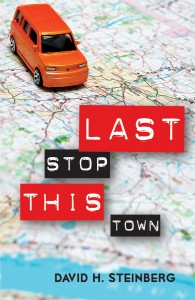Author addresses teen life
Many writers have struggled with the coming-of-age concept. Even though some authors believe they have accurately depicted the “crazy” world of teenagers, writers’ portrayals often end up looking desperate and out of touch.
It doesn’t help that generational gaps are often far too large for adults to truly understand the current teenage mindset: How often have we listened to our parents painfully try — and fail — to sing along to Drake?

Teenage wasteland · Steinberg bridges the generational gap between teens and adults in his realistic coming-of-age novel Last Stop This Town. - Photo courtesy of David H. Steinberg
Unless you’re a part of a generation, it can be very difficult to accurately portray it. And the worst part is that this difficulty so readily appears in works that purport themselves to be genuine.
Author David H. Steinberg’s Last Stop This Town, however, is an outlier. Steinberg, screenwriter for movies like American Pie 2 and Slackers, has crafted a novel that is impressively in touch with this generation and speaks honestly to it. Though most novels grasp at straws in an attempt to seem authentic, Steinberg is able to look into the inner psyche of the teenager.
And in an effort to “tap into” Generation X, many authors lose insight into what life means to young people, despite these stereotypes; Steinberg has, impressively, avoided that here.
Last Stop This Town tells the story of several male high school seniors living their last few weeks of adolescence: Soon, they will be making their trek as adults into a world with uncertain futures. And though the premise might seem tired, Steinberg expertly portrays the lives of these characters, exploring them in depth.
Plenty of novels include the customary “friendship pack”: A group of seniors promise to lose their virginity or live every last high school day to its fullest. But Last Stop This Town understands the power of stereotypes and manages to enforce and twist them around to create an interesting and hilarious narrative.
Four best friends comprise the novel’s main cast of characters, and though they each carry their specific personality — the guy who gets around, the stoner, the friend always arguing with his girlfriend and the one who’s just there to see it all — each of the characters are so fully explored in depth that readers feel as if they know the characters’ personally.
Dylan, who Steinberg describes as a boy with a “vintage Zac Efron thing going on with his hair,” is an attractive young man with the world at his feet.
In the hands of any other writer, Dylan could fall into a caricature and be a stiffly successful, vanilla bore of a character. Steinberg, however, somehow toes the line between stereotype and real life, filling the character with the right amount of whimsy and ridiculousness to make him seem real.
Last Stop This Town wisely utilizes the third person and doesn’t delve too much into veiled metaphors; instead of having to figure things out, readers are simply — but effectively — given the insight to what each character is thinking, allowing you to concentrate on the laughs and not any ridiculous symbolism.
That’s partly what Steinberg does so well: He knows exactly what kind of writer he needs to be and doesn’t try to overextend his reach. There are no painful attempts to be artistic or any forced jargon. Instead, Steinberg has simply written what he knows, and it reads as authenticity at its best.
Some might be tempted to compare Last Stop This Town to the American Pie series. Yes, the novel reeks of American Pie influences, but it’s understandable considering Steinberg’s work as a screenwriter on the seminal coming-of-age series.
Though the American Pie films were everything short of artistic, they were certainly funny and real. Last Stop This Town is another example of the coming-of-age narrative done right, and Steinberg wisely conveys the most important element of the of story: the characters.
To be fair, Last Stop This Town isn’t perfect. Most notably, the novel falls into a bit of hackneyed territory whenever the characters are alone and there’s no one to exchange hilarious witty banter with.
Still, that’s a small price to pay to be able to finally experience teenagers just being teenagers: no vampires, no werewolves, no dystopian last-person-standing battles — just boys ready and excited to start the rest of their lives.
